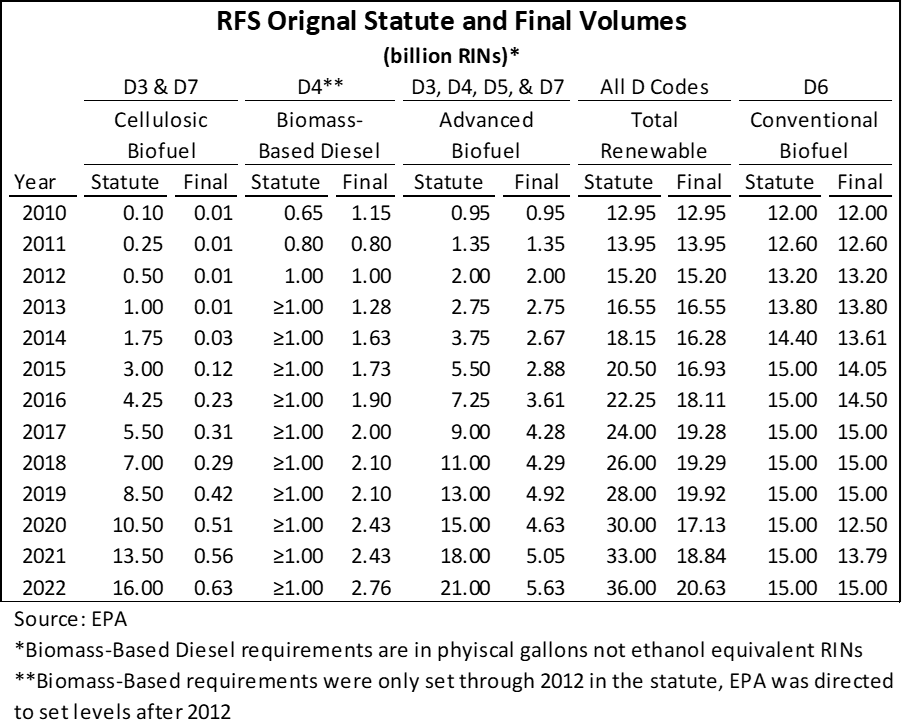RFS Overview and Proposed Rules
Author
Published
1/24/2023
The Renewable Fuel Standard: An Overview of the Current Program and How Proposed Changes Could Affect Agriculture
Program Overview
The Renewable Fuel Standard (RFS) was created by Congress in 2005 and updated by Congress in 2007 to its current form. The program mandates a minimum volume of renewable fuel must enter U.S. fuel supply each year. The program is regulated by the EPA.
Under the RFS program renewable fuels are broken into five major classes: D3, D4, D5, D6, and D7 (Table 1). Each class has certain requirements the fuel must meet like feedstock and greenhouse gas (GHG) emission reduction requirements. For example, to be classified as D6, the fuel needs to release 20% less GHG emissions over its life than the petroleum products it is replacing. Other codes are more restrictive, for example D3 requires that GHG emissions be 60% below petroleum products and specifies that corn starch cannot be the feedstock.
Table 1. RFS Fuel Code Outline

In 2007, Congress set renewable fuel targets for four categories of renewable fuel. The categories and how they related to the codes are shown in Table 2. Cellulosic biofuel includes D3 and D7 fuels, biomass-based diesel fuel includes only D4 fuels, advanced biofuel includes D5 fuels, but D3, D4, and D7 fuels can also be used to comply with this requirement if the more restrictive requirements are already met. Total renewable fuel can include any D-code and is the only category that includes the D6 code, which is primarily ethanol made from corn.
Targets are set in terms of RINs, or ethanol gallon equivalents, except for biomass-based diesel, which was set in terms of actual gallons of fuel. Targets represent the minimum amount of renewable fuel that must be included in the fuel supply by fuel refineries and importers. Targets set in the 2007 statutes are shown in Table 3 in the columns marked statute. Conventional biofuel is not actually reported in statute but is calculated as Total Renewable Fuel minus Advanced Biofuel.

Table 2. Classification of RFS Fuel Codes

Table 3. RFS Original Statute and Final Volumes
Refiners and importers of petroleum fuel must comply with the RFS. These obligated parties demonstrate compliance with the RFS each year by retiring Renewable Fuel Identification Numbers (RINs). RINs are unique numbers generated when a producer of renewable fuel makes the renewable fuel. A RIN is assigned to every gallon of eligible fuel at the time of production. Obligated parties can either buy renewable fuel and the RINs with them to get their required RINs, or they can buy RINs from other obligated parties who purchase and blend more renewable fuel than they need to comply with the RFS. The price of RINs is determined by the supply and demand for RINs within the market.
To determine how much renewable fuel or how many RINs each obligated party needs to comply with the standard, percentage targets are calculated based on US fuel consumption estimates. The result is the percentage of fuel that must be renewable each year. Historic blending requirements calculated by EPA are shown in Table 4.
Table 4. RFS Final and Proposed Blending Requirements

EPA Authority
In 2007 Congress set RFS targets through 2022 for all fuel categories except biomass-based diesel which was set through 2012. Congress understood renewable fuel markets might not develop fast enough to meet the requirements specified by the statute. Therefore, EPA was given the authority to change targets if the market for a certain fuel could not realistically meet the statutory requirement. Furthermore, EPA was also given the authority to set targets beyond 2012 for biomass-based diesel and beyond 2022 for all fuel categories when the original targets set by Congress expired.
The EPA has lowered the volume requirements for cellulosic biofuel, advanced biofuel, and total renewable fuel relative to the original statute many times since the RFS began (Table 3). These adjustments were made to create targets deemed more realistic by EPA as production of some fuels did not develop as fast as the original legislation implied. Recent targets set by EPA have been much lower than the original statue for cellulosic biofuel, advanced biofuel, and total renewable fuel.
Historic RIN Generation
RINs generated each year, the yearly requirement, and the difference between production and the annual RFS requirement is shown in Table 5 for each renewable fuel category. December RIN production data is not yet available for 2022 so most production numbers are smaller than the requirement for 2022.
It is important to note that RINs that are not retired to meet RFS requirements in the year they are generated can be carried forward. Furthermore, an obligated party that does not meet its requirement in a given year may carry a RIN deficit forward for one year only. These two reasons mean it is possible to have fewer RINs produced in one year than are required, but compliance with the RFS is still met.
Table 5. RFS Final Volumes and Net Production

Changes Proposed by EPA
The EPA’s first proposal of new targets covering 2023 to 2025 were released on November 30, 2022. The released targets in each of the four categories are included in Table 5. The implied blending requirements were given in Table 4. Again, these numbers for 2023-2025 are not yet official, they have been proposed by the EPA and the EPA is currently taking comments on these numbers for consideration before finalizing them.
How Proposed Blending Levels Could Affect Agriculture?
The RFS Program incentivizes the use of biofuels. Higher volume requirements put more pressure on blenders of fuel to use biofuels and create more incentives for investment into biofuel production. Major agricultural biofuels are corn ethanol, which is a D6 fuel and falls under conventional biofuel, and biodiesel and renewable diesel, which are both D4 fuels and fall under biomass-based diesel fuel.
Conventional biofuel requirements were raised in the EPA proposal which is good for the ethanol industry. However, biomass-based diesel fuel requirements were raised less than expected. Notice in Table 5 that biomass-based diesel production has consistently surpassed its requirement under the RFS. Also, future requirements, even those in 2025, are below current production levels. EPA wants to avoid setting targets above what the market can deliver, but given current production is well above target levels and both soybean crush and renewable diesel production are expected to increase in the coming years, it was strange to see these numbers as low as they were. Should these proposed requirements stand, biodiesel and renewable diesel will have less than anticipated support from the RFS program in the coming years.
Electric RINs
Another area of interest to many is EPA’s recent proposal to begin including electric vehicles in the RFS framework. Electricity produced from qualified renewable biomass and used as transportation fuel would be available to claim electric RINs (eRINs).
The EPA outlined its proposed approach and other alternative approaches for eRIN generation in its proposal. The EPA’s proposed approach would allow electric vehicle manufacturers, called original equipment manufacturers (OEMs) in its proposal, to generate eRINs based on their light duty electric vehicle sales if they establish contracts with parties that produce electricity from qualifying biogas (renewable electricity generators).
Alternative approaches noted by the EPA included allowing producers of renewable electricity to generate eRINs, allowing public access charging stations to generate eRINs, allowing independent third parties to generate eRINs, and several hybrid approaches that allow multiple parties described above to generate eRINs. The EPA acknowledged they are open to hearing public comment on its proposed approach or any alternative approach.
How eRINs Could Affect Agriculture?
In its proposal, EPA noted there are currently production pathways in place to generate RINs from electricity derived from biomass, but due to regulatory questions the EPA has never registered any party to generate RINs from renewable electricity using one of its approved pathways despite requests. EPA also noted at this time they are not proposing any new pathways to generate RINs from electricity. There are currently two approved pathways for RIN generation from electricity. One pathway is a D3 and the other is a D5.
As mentioned above, major agricultural biofuels are D4 and D6 pathways, so in the short-term if eRINs are approved, eRINs should not displace any major agricultural biofuels in the RFS.
The long-term outlook if eRINs are approved is less clear. If D4 or D6 pathways for renewable electricity were to be proposed and approved in the future, this would have the potential to displace agricultural biofuels in the RFS. Furthermore, how future RFS requirements will be set if eRINs are approved will have implications for agricultural biofuels. Should eRINs be approved, future requirements could be set for eRINs displacement of only petroleum products, not biofuels, though this could become difficult as ethanol is currently dependent on being blended with petroleum-based gasoline. Another possibility is eRINs could begin to displace both petroleum products and agricultural biofuels. Time will tell if eRINs will be authorized to displace agricultural biofuels in the RFS.
Economic analysis provided by Aaron Gerdts, Research Analyst, Decision Innovation Solutions on behalf of Iowa Farm Bureau.
Want more news on this topic? Farm Bureau members may subscribe for a free email news service, featuring the farm and rural topics that interest them most!